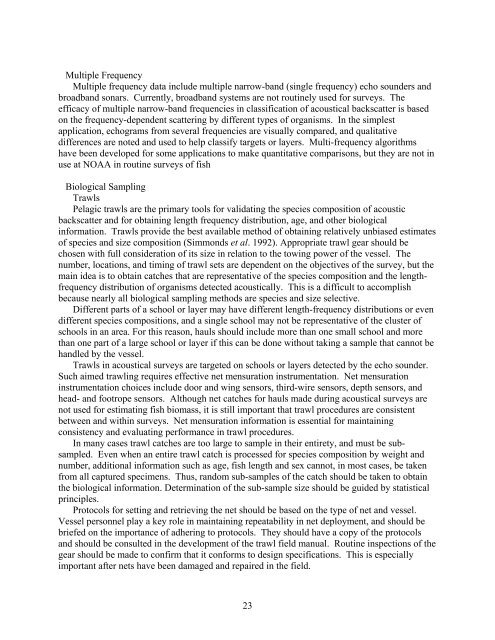NOAA Protocols for Fisheries Acoustics Surveys and Related ...
NOAA Protocols for Fisheries Acoustics Surveys and Related ...
NOAA Protocols for Fisheries Acoustics Surveys and Related ...
You also want an ePaper? Increase the reach of your titles
YUMPU automatically turns print PDFs into web optimized ePapers that Google loves.
Multiple Frequency<br />
Multiple frequency data include multiple narrow-b<strong>and</strong> (single frequency) echo sounders <strong>and</strong><br />
broadb<strong>and</strong> sonars. Currently, broadb<strong>and</strong> systems are not routinely used <strong>for</strong> surveys. The<br />
efficacy of multiple narrow-b<strong>and</strong> frequencies in classification of acoustical backscatter is based<br />
on the frequency-dependent scattering by different types of organisms. In the simplest<br />
application, echograms from several frequencies are visually compared, <strong>and</strong> qualitative<br />
differences are noted <strong>and</strong> used to help classify targets or layers. Multi-frequency algorithms<br />
have been developed <strong>for</strong> some applications to make quantitative comparisons, but they are not in<br />
use at <strong>NOAA</strong> in routine surveys of fish<br />
Biological Sampling<br />
Trawls<br />
Pelagic trawls are the primary tools <strong>for</strong> validating the species composition of acoustic<br />
backscatter <strong>and</strong> <strong>for</strong> obtaining length frequency distribution, age, <strong>and</strong> other biological<br />
in<strong>for</strong>mation. Trawls provide the best available method of obtaining relatively unbiased estimates<br />
of species <strong>and</strong> size composition (Simmonds et al. 1992). Appropriate trawl gear should be<br />
chosen with full consideration of its size in relation to the towing power of the vessel. The<br />
number, locations, <strong>and</strong> timing of trawl sets are dependent on the objectives of the survey, but the<br />
main idea is to obtain catches that are representative of the species composition <strong>and</strong> the lengthfrequency<br />
distribution of organisms detected acoustically. This is a difficult to accomplish<br />
because nearly all biological sampling methods are species <strong>and</strong> size selective.<br />
Different parts of a school or layer may have different length-frequency distributions or even<br />
different species compositions, <strong>and</strong> a single school may not be representative of the cluster of<br />
schools in an area. For this reason, hauls should include more than one small school <strong>and</strong> more<br />
than one part of a large school or layer if this can be done without taking a sample that cannot be<br />
h<strong>and</strong>led by the vessel.<br />
Trawls in acoustical surveys are targeted on schools or layers detected by the echo sounder.<br />
Such aimed trawling requires effective net mensuration instrumentation. Net mensuration<br />
instrumentation choices include door <strong>and</strong> wing sensors, third-wire sensors, depth sensors, <strong>and</strong><br />
head- <strong>and</strong> footrope sensors. Although net catches <strong>for</strong> hauls made during acoustical surveys are<br />
not used <strong>for</strong> estimating fish biomass, it is still important that trawl procedures are consistent<br />
between <strong>and</strong> within surveys. Net mensuration in<strong>for</strong>mation is essential <strong>for</strong> maintaining<br />
consistency <strong>and</strong> evaluating per<strong>for</strong>mance in trawl procedures.<br />
In many cases trawl catches are too large to sample in their entirety, <strong>and</strong> must be subsampled.<br />
Even when an entire trawl catch is processed <strong>for</strong> species composition by weight <strong>and</strong><br />
number, additional in<strong>for</strong>mation such as age, fish length <strong>and</strong> sex cannot, in most cases, be taken<br />
from all captured specimens. Thus, r<strong>and</strong>om sub-samples of the catch should be taken to obtain<br />
the biological in<strong>for</strong>mation. Determination of the sub-sample size should be guided by statistical<br />
principles.<br />
<strong>Protocols</strong> <strong>for</strong> setting <strong>and</strong> retrieving the net should be based on the type of net <strong>and</strong> vessel.<br />
Vessel personnel play a key role in maintaining repeatability in net deployment, <strong>and</strong> should be<br />
briefed on the importance of adhering to protocols. They should have a copy of the protocols<br />
<strong>and</strong> should be consulted in the development of the trawl field manual. Routine inspections of the<br />
gear should be made to confirm that it con<strong>for</strong>ms to design specifications. This is especially<br />
important after nets have been damaged <strong>and</strong> repaired in the field.<br />
23
















